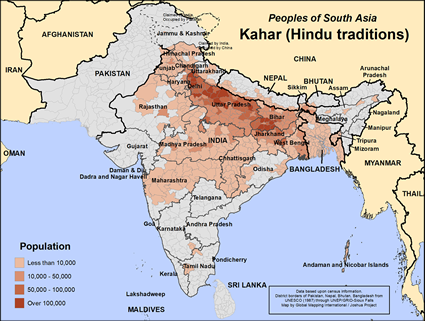Kahar (Hindu traditions) in Nepal

Photo Source:
Anonymous
|

Map Source:
People Group Location: Omid. Other geography / data: GMI. Map Design: Joshua Project
|
| People Name: | Kahar (Hindu traditions) |
| Country: | Nepal |
| 10/40 Window: | Yes |
| Population: | 56,000 |
| World Population: | 8,522,000 |
| Primary Language: | Bhojpuri |
| Primary Religion: | Hinduism |
| Christian Adherents: | 0.00 % |
| Evangelicals: | 0.00 % |
| Scripture: | Complete Bible |
| Ministry Resources: | Yes |
| Jesus Film: | Yes |
| Audio Recordings: | Yes |
| People Cluster: | South Asia Hindu - Kahar |
| Affinity Bloc: | South Asian Peoples |
| Progress Level: |
|
Introduction / History
It seems likely that this caste is a remnant of one of the ethnic groups who occupied the valley of the Ganges before the coming of the Aryans.
What Are Their Lives Like?
In villages some are engaged in carrying water for high-ranking communities in the event of marriage, death and other occasions.
What Are Their Beliefs?
The worldview of the Kahar is very different than the biblical worldview. For example, they have no concept of resurrection, a key belief for Christ followers. Brahmins are their sacred priests. One of the main ceremonies associated with marriage is to circle the sacred fire seven times.
What Are Their Needs?
The Kahar people in Nepal have few if any chances to hear about the wonderful grace of Jesus Christ. There are probably no Christ followers among them, and few Christians live nearby. Fortunately, they speak Bhojpuri, the language of many who believe. Tools (JESUS Film, recordings, videos, etc.) are available in most of the languages spoken by the Kahar community, but workers are needed to carry these tools to the people.
Prayer Points
We trust the Lord will soon call out his followers from among the Kahar community. Pray they will be patient with each other, bearing with one another in love.
Pray the Kahar will understand that Jesus desires to bless their families and clans, not harm them.
Pray they will be able to raise their standard of living and be well equipped for the challenges of the 21st century.